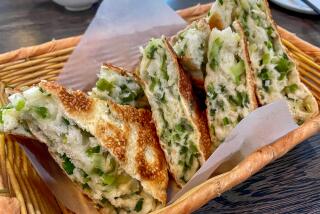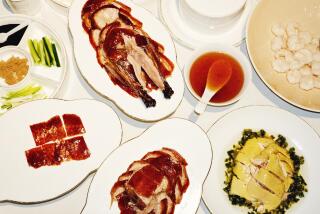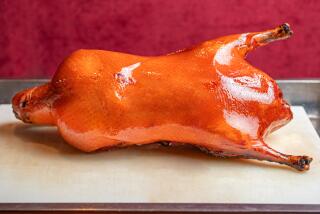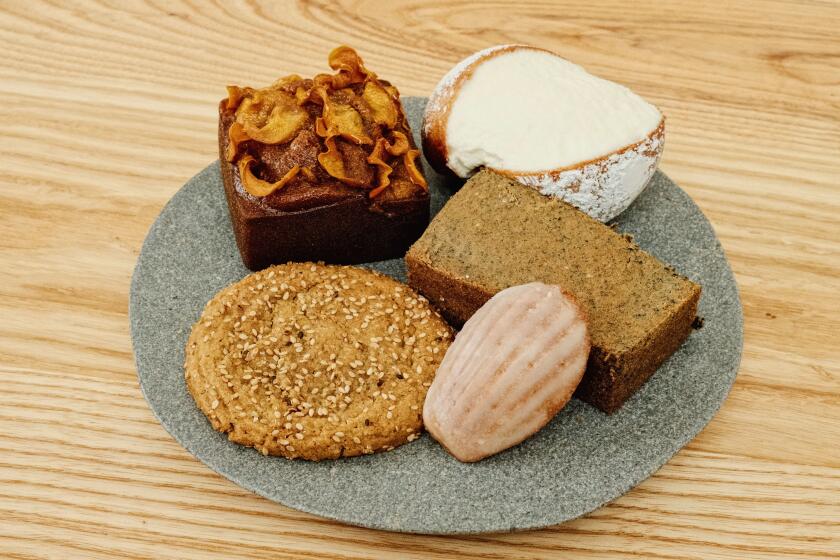Dine-in duck
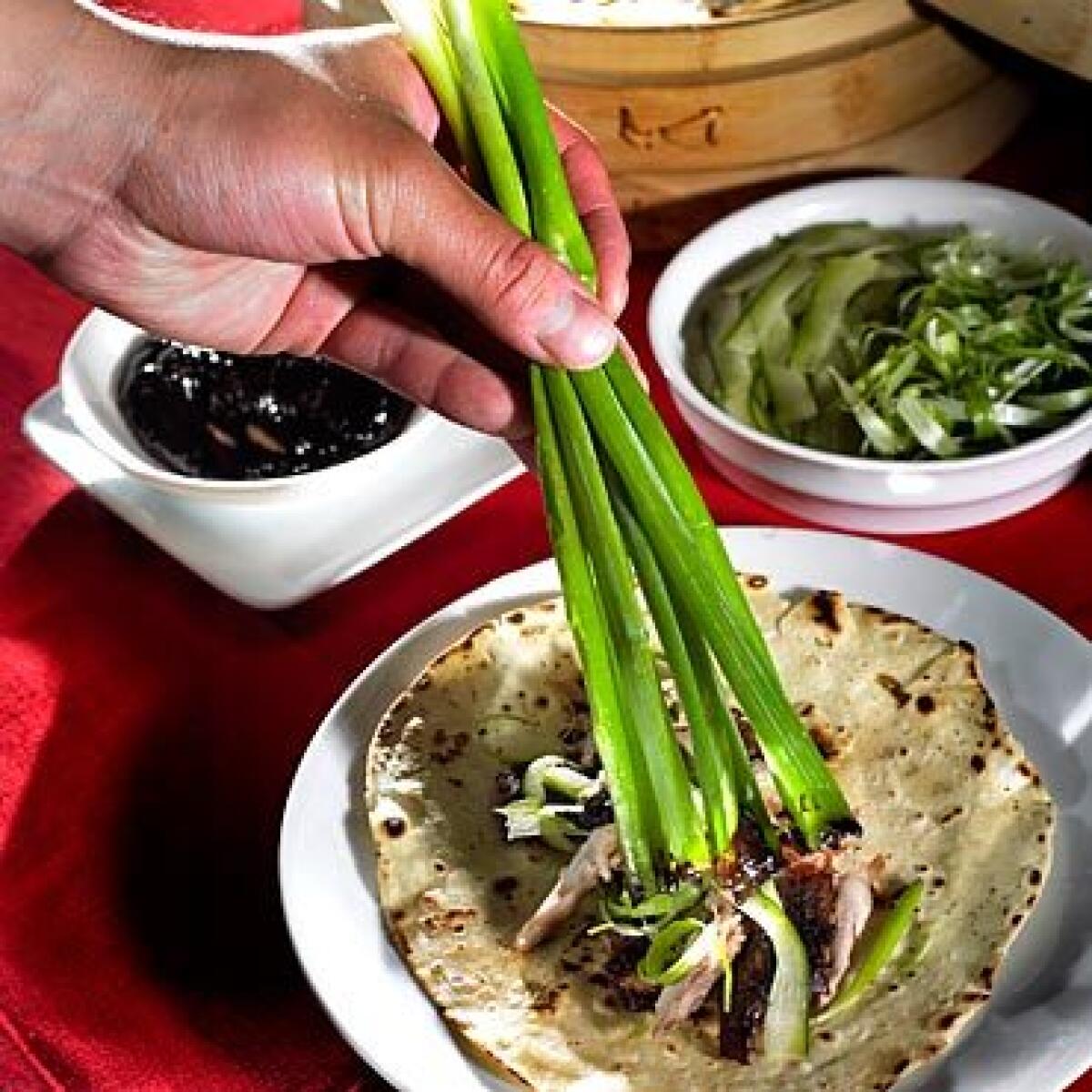
A Peking duck dinner is a feast built from a single ingredient. It starts with nibbling on a taco-like snack of the delicately crisp skin tucked inside thin mandarin pancakes with a lick of earthy bean sauce. That’s followed by a simple stir-fry featuring the gamey meat with lots of fragrant ginger and scallion. Finally, a rich soup infused by the remaining bones and bits is offered to cleanse the palate.
It’s a production that until recently I didn’t have the gumption to tackle. I let the pros at Chinese restaurants do the work. But those meals were rarely as regal as those described in books. Though the skin was always crisp, the flesh was sometimes mealy or the pancakes were mass-produced and characterless. When the courses arrived too fast and overlapped, flavors got jumbled up, diminishing the overall experience.
I was never truly satisfied, but making the Chinese classic myself seemed like a culinary deed of derring-do, beyond the reach of mere mortals. Then, around Lunar New Year in February, I decided that I’d had enough with paying for so-so duck dinners and would try to master Peking duck three ways. After several months of trying, I think I’ve succeeded.
The first and biggest hurdle was figuring out the duck itself. There’s an entire mythology around it. The duck must be whole and has to be eviscerated through a hole in one of the armpits; you have to pump air between the skin and flesh to detach the skin so the fat will drip off during roasting (the key to creating the signature crisp-yet-not-oily skin). The skin needs to be scalded, rubbed with diluted sugar syrup and then dried in chilly, open-air conditions. Finally, the duck needs to be cooked suspended over a live fire, preferably stoked by fragrant jujube wood.
That’s a lot to do for one dinner. But rather than ducking the issue, I took it as a puzzle to solve.
The armpit requirement was not possible, but obtaining a freshly killed duck with its head and feet intact was not hard. Chinese markets and Chinatown poultry shops sell plenty of well-priced ones. Even better, most ducks bred for consumption in America are of the Pekin variety, also known as Long Island duck. Was the Kitchen God on my side or what?
Blowing air into the duck didn’t require vast lung power and a bamboo straw, or operating an air compressor as Ming Tsai did on the “Battle Duck” episode of “Iron Chef.” I used what was available at my home: the plastic foot pump that came with my exercise ball. (A bicycle pump would work too.) I “sewed” up the cavity with a bamboo skewer and used a paring knife to cut a tiny hole at the base of the duck’s neck. The duck inflated like a charm.
Scalding and tanning the skin are typically done as a two-step procedure with the duck suspended from a meat hook. That proved overly fussy, so I combined the steps. I put away the hook, placed the duck on a baking sheet and simply ladled over a hot soy, honey and wine mixture, a tip from Chinese food expert Ken Hom that yielded extra savor and a mahogany color.
At first I tried leaving the duck to dry in my cool garage, but it started to take on a slightly funky smell. Instead, I air-chilled my next duck in the refrigerator for a couple of days and at the end, the duck had developed an enviable tan reminiscent of the Bain de Soleil commercials of my youth.
The duck-drying days bought me time to make mandarin pancakes and, maybe most important, figure out how to bring the entire meal together — the roasting, stir-frying, brewing of the broth and, ultimately, serving of the meal.
Restaurants that specialize in Peking duck have special ovens and trained staff. Plus, they are always a duck ahead of their diners, meaning there is broth constantly simmering. My workarounds included cooking the duck on a vertical roaster to facilitate even heat circulation, prepping as much in advance as possible, keeping the stir-fry simple and fast, and doctoring up canned chicken broth for the soup.
As it turns out, the pancakes can be refrigerated for days and freeze beautifully for weeks. I realized after several trials that once the duck is roasted, its glossy skin stays crisp for a good hour, allowing me to start the broth, assemble the stir-fry ingredients and even clean up the kitchen a little bit before guests arrived.
Sure, I had to run back and forth between the kitchen and table during the serving, but it was worth it. My family and friends were as amazed as I was that terrific Peking duck could be made at home in a regular oven with no super-special equipment.
I had slain the mythological beast and come out with a darned good duck.
Nguyen is the author of the blog Viet World Kitchen.
More to Read
Eat your way across L.A.
Get our weekly Tasting Notes newsletter for reviews, news and more.
You may occasionally receive promotional content from the Los Angeles Times.
